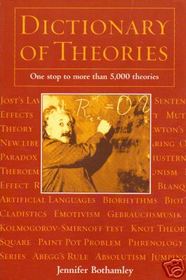FROM THE PUBLISHER
The Dictionary of Theories is the first multi-disciplinary reference book to bring together theories, laws, hypotheses, principles, rules, theorems, ologies, and isms from all subject areas. With more than 5,000 entries, the Dictionary of Theories is a unique and handy reference for the inquiring reader who wants to know more about the many theories cited daily in newspapers and magazines and on television, radio, and the Internet.
Alphabetically arranged entries cover the arts, economics, history, linguistics, philosophy, psychology, sociology, hard sciences, and more.
Ancient and modern, accepted and discredited, all theories that have relevance in todays world are included. The depth of the terms varies from undergraduate level to the more populist, with theories such as Parkinsons law and the Peter Principle included.
Each theory gives the name and date of the theory; subject area; the name, nationality, and dates of the discoverer; a concise description of the theory and a comment about its validity; and, where appropriate, a one-item bibliography giving details of a title in which a fuller explanation can be found. Equations and technical diagrams have also been included.
Weve got your theory! Extensive cross-references allow you to browse within areas and across discipline. And the two indexes enable you to see which entries are covered by each subject area and the names and dates of the people associated with each theory.
The Dictionary of Theories is the first multi-disciplinary reference book to bring together theories, laws, hypotheses, principles, rules, theorems, ologies, and isms from all subject areas. With more than 5,000 entries, the Dictionary of Theories is a unique and handy reference for the inquiring reader who wants to know more about the many theories cited daily in newspapers and magazines and on television, radio, and the Internet.
Alphabetically arranged entries cover the arts, economics, history, linguistics, philosophy, psychology, sociology, hard sciences, and more.
Ancient and modern, accepted and discredited, all theories that have relevance in todays world are included. The depth of the terms varies from undergraduate level to the more populist, with theories such as Parkinsons law and the Peter Principle included.
Each theory gives the name and date of the theory; subject area; the name, nationality, and dates of the discoverer; a concise description of the theory and a comment about its validity; and, where appropriate, a one-item bibliography giving details of a title in which a fuller explanation can be found. Equations and technical diagrams have also been included.
Weve got your theory! Extensive cross-references allow you to browse within areas and across discipline. And the two indexes enable you to see which entries are covered by each subject area and the names and dates of the people associated with each theory.




